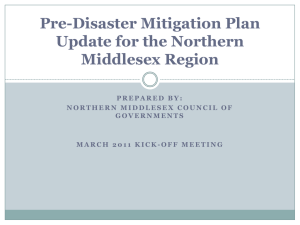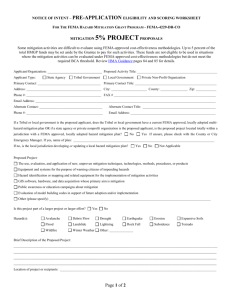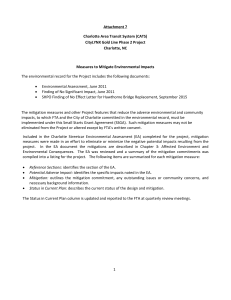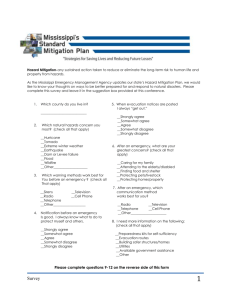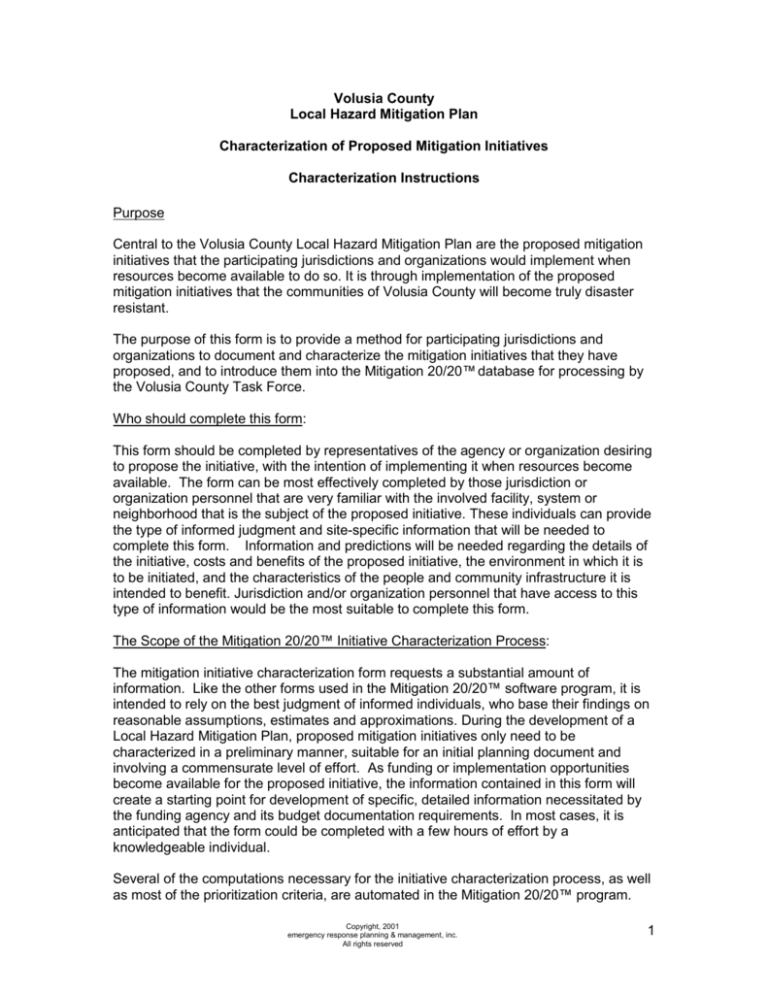
Volusia County
Local Hazard Mitigation Plan
Characterization of Proposed Mitigation Initiatives
Characterization Instructions
Purpose
Central to the Volusia County Local Hazard Mitigation Plan are the proposed mitigation
initiatives that the participating jurisdictions and organizations would implement when
resources become available to do so. It is through implementation of the proposed
mitigation initiatives that the communities of Volusia County will become truly disaster
resistant.
The purpose of this form is to provide a method for participating jurisdictions and
organizations to document and characterize the mitigation initiatives that they have
proposed, and to introduce them into the Mitigation 20/20™ database for processing by
the Volusia County Task Force.
Who should complete this form:
This form should be completed by representatives of the agency or organization desiring
to propose the initiative, with the intention of implementing it when resources become
available. The form can be most effectively completed by those jurisdiction or
organization personnel that are very familiar with the involved facility, system or
neighborhood that is the subject of the proposed initiative. These individuals can provide
the type of informed judgment and site-specific information that will be needed to
complete this form. Information and predictions will be needed regarding the details of
the initiative, costs and benefits of the proposed initiative, the environment in which it is
to be initiated, and the characteristics of the people and community infrastructure it is
intended to benefit. Jurisdiction and/or organization personnel that have access to this
type of information would be the most suitable to complete this form.
The Scope of the Mitigation 20/20™ Initiative Characterization Process:
The mitigation initiative characterization form requests a substantial amount of
information. Like the other forms used in the Mitigation 20/20™ software program, it is
intended to rely on the best judgment of informed individuals, who base their findings on
reasonable assumptions, estimates and approximations. During the development of a
Local Hazard Mitigation Plan, proposed mitigation initiatives only need to be
characterized in a preliminary manner, suitable for an initial planning document and
involving a commensurate level of effort. As funding or implementation opportunities
become available for the proposed initiative, the information contained in this form will
create a starting point for development of specific, detailed information necessitated by
the funding agency and its budget documentation requirements. In most cases, it is
anticipated that the form could be completed with a few hours of effort by a
knowledgeable individual.
Several of the computations necessary for the initiative characterization process, as well
as most of the prioritization criteria, are automated in the Mitigation 20/20™ program.
Copyright, 2001
emergency response planning & management, inc.
All rights reserved
1
Therefore, this form only requests the necessary input information and, upon entry of the
data, these factors will be calculated. While the form will be incomplete in the sense that
several of the prioritization results are not shown, the output of the Mitigation 20/20™
program and the Volusia County Local Hazard Mitigation Plan will reflect all of these
results.
Suggested Approach:
It is suggested that the Task Force support staff make several copies of this form
available to representatives of all participating jurisdictions at the beginning of the
planning period. Key organizations may also wish to develop proposed mitigation
initiatives, and they will also need copies of these instructions and the form.
By distributing the form early in the planning process, it will be available for use
throughout the planning process at any time the participant wishes to develop and
submit an initiative. In order to complete the Volusia County Local Hazard Mitigation
Plan, the information will be needed by the Task Force staff for entry into the Mitigation
20/20™ software program.
The Task Force support staff will also need to provide training to representatives of the
jurisdictions in how to develop the initiatives and complete the forms. A deadline for
submittal of completed forms should also be set, and this deadline should be consistent
with allowing time for the support staff to enter data and prepare the next edition of the
plan.
Individuals intending to complete the forms will need, in most cases, need the following
types of information:
One copy of the form for every mitigation initiative to be proposed,
A copy of the Task Force’s statements of planning goals and objectives for the
current planning period,
Vulnerability information regarding the facility, system or neighborhood of
concern,
Information regarding the characteristics of the initiative intended to be proposed,
such as what it will be, its likely cost, the needed permits, etc. using the form as a
guide,
Information and estimates regarding the intended benefits of the proposal, such
as the damages to be avoided, the number of people to be benefited, the
economic benefits, etc.
Upon receipt of the completed forms from the jurisdictions and other participating
organizations, the support staff must then enter the information from each into the
Mitigation 20/20™ program in order to complete the process.
The characterization form is attached.
Copyright, 2001
emergency response planning & management, inc.
All rights reserved
2
Volusia County
Local Hazard Mitigation Plan
Characterization of Proposed Mitigation Initiatives
Characterization Form
Jurisdiction Name:
Date form completed:
Organization/agency submitting initiative: Volusia County Emergency Management
Contact Individual Name:
Address:
Phone:
Is this initiative new or a revision of an earlier initiative? ( one) New
Revision
If it is a revision, give the title of the initiative previously used and date submitted:
If this is a request to remove a previously entered initiative from the Volusia County Local
Hazard Mitigation Plan, check this box:
(Note that the Steering Committee must concur with a request prior to remove or terminate
previously authorized mitigation initiatives from the plan.)
If this initiative was developed pursuant to inter-agency agreements, list applicable agreement
name(s) here:
I.
INITIATIVE DESCRIPTION
Initiative Name:
Briefly describe the initiative:
the category of the initiative:
Structural
Non-structural
Mixed/both
If the initiative is structural or involves a specific location, attach a map showing the location.
if map is attached:
Write the “planning objective” established by the Task Force that is most applicable to this
initiative:
Copyright, 2001
emergency response planning & management, inc.
All rights reserved
3
If there are facilities, neighborhoods, or repetitive loss properties that would be affected by this
initiative, list them here:
Facilities
Neighborhoods
Repetitive Loss Properties
If there are existing plans or programs that will be modified by this initiative, list them here:
Anticipated Next Update (date)
Plan/Program Name
Identify the hazards intended to be addressed by this initiative:
Natural Hazard
High winds
Flooding
Storm surge, tsunami
Earthquake
Landslide, erosion
Sever winter storm
Major fire
Lightning
Drought
Hail
Infestation, disease
Other natural hazard
Technological Hazards
Hazardous materials
Loss of electric service
Loss of water service
Loss of sewer service
Loss of gas services
Telecommunications failure
Radiological accident
Other technological hazard
Societal Hazards
Crime
Civil disturbance
Terrorism
Economic crisis
Key employer crisis
Other societal hazard
Describe the “worst case” disaster scenario and its direct and indirect impact on the facility,
system or neighborhood to be protected by the proposed initiative:
What is the dollar value of the total direct losses for damages or destruction to the facility,
system or neighborhood likely in this scenario: $
What is the dollar value of the total indirect losses (e.g., lost job income, lost revenue, extra
operating costs, etc.) likely in this scenario: $
Total of direct and indirect losses under this scenario: $
Will the initiative avoid or prevent all of these direct and indirect losses?
If no, what percent decrease in losses can be estimated?
%
yes
no
What is the adjusted direct and indirect losses under this scenario (The total of direct and
indirect losses multiplied by the percentage of decrease in losses): $
Copyright, 2001
emergency response planning & management, inc.
All rights reserved
4
How many people would be injured, sickened or killed in the “worst case” scenario without this
initiative?
injured,
sickened,
killed
Are there valuable or irreplaceable cultural, historic or environmental resources that would be
protected by the initiative?:
yes
no
If yes, list or describe these resources:
II.
INITIATIVE BENEFITS
Is a designated “critical facility” to be benefited by the proposal?:
If yes, give the following information for each facility benefited:
Facility Name/Description
yes
no
Type of Critical Facility
Describe the consequences of the total or partial loss of the critical facility(ies) listed in the
“worst case” scenario:
For all types of proposed initiatives, including those for protection of critical facilities, give the
following:
1. Number of people directly and indirectly benefited:
2. Percentage of the jurisdiction’s population or organization’s client based benefited:
%
3. Number of structures to be benefited:
4. Total estimated value of the structures and contents: $
5. Number of businesses to be benefited:
6. Total estimated number of employees benefited:
7. Valuable environmental resources to be protected?:
yes
no
8. Valuable cultural or historic resources to be protected?:
yes
no
If #7 or #8 are “yes,” provide the following for each:
Name of resource
Location/address
Copyright, 2001
emergency response planning & management, inc.
All rights reserved
Size (acres, #
of structures,
etc.)
Current Status
(Registered,
protected, etc.)
5
IV.
COST OF THE PROPOSED INITIATIVE
Estimate the total cost to implement to proposal (for design and construction, purchase and
installation, etc.) $
What is the projected life of the project?
years
Calculate the annual cost to implement the proposal? (Divide the cost to implement the
proposal by its useful life):
$ per year
Provide an estimate for any annual maintenance costs:
$ per year
Determine the total annual cost to implement and maintain the proposal (Add the annual cost to
implement the proposal to the annual cost to maintain the proposal):
$ per year
Briefly explain the justification used to estimate the cost to implement:
V.
THE COST IMPACT OF THE PROPOSAL
Some mitigation initiatives could result in costs to others for their implementation, in addition to costs to the proposal’s
sponsor or the organization that implements the proposal. This section allows the “cost impact,” if any, to be
estimated.
Provide an estimate of the initial cost impact of implementation: $
Estimate the annualized immediate cost impact of implementation (Divide the initial cost impact
by the useful life of the proposal):
$ per year
Include any anticipated annual impact costs:
$ per year
Calculate the annualized cost impact of the proposal (Add the annualized immediate cost
impact to the annual ongoing cost impacts):
$ per year
Identify the group most likely to bear this cost impact (Check all that apply):
Group
The general public
Buyers of property
Developers/builders
Property owners
Transients/tourists
Group
Educational institutions
Retail businesses
Service businesses
Manufacturers
Tourism businesses
Group
Health care facilities
Local government
Public safety organizations
Local Utilities
Other:
VI.
COMPARISON OF BENEFITS TO COSTS
A.
List the total annualized cost of “not taking action” or not implementing the proposal.
(This is the adjusted direct and indirect losses divided by the useful life of the proposal):
$ per year
Copyright, 2001
emergency response planning & management, inc.
All rights reserved
6
B.
Give the total annualized cost to implement (From above):
$ per year
C.
Give the total annualized cost impact of implementation (From above):
year
$ per
Calculate the preliminary benefit to cost ratio (Divide “A” by the sum of “B” + “C”):
The preliminary benefit to cost ratio only considers values that can be measured in dollars. The Mitigation 20/20™
approach considers “intangible” benefits of the proposed initiative as well, such as lives saved and injuries prevented,
as well as valuable environmental or cultural resources protected. This is done by applying “multipliers” to the
preliminary benefit to cost ratio to increase it to a level commensurate with the intangible benefits it would derive.
These multipliers are the following:
Multiplier Value
Multiplier Value
Valuable Resource Factor
1.0
1.5
No benefit
Benefits up to 1,000 people
1.0
1.1
2.0
Benefits 1, to 50,000 people
1.3
2.5
Benefits 50,000 to 250,000
people
Benefits more than 250,000
people
1.5
No benefit
Benefits less than 10 acres or
one structure/site
Benefits 10-50 acres or two
structures sites
Benefits more than 50 acres or
more than 2 structures
3.0
Public Health and Safety Factor
Calculate the adjusted benefit to cost ratio for the proposal (multiply the preliminary ratio by the
applicable multiplier(s) listed in the table):
VII.
FEASIBILITY OF IMPLEMENTATION
Check the statement that most applies to this proposal regarding its consistency with other
applicable plans, programs or policies of the jurisdiction or proposing agency:
The proposal is listed in at least 3 other documents or is highly consistent w/ other plans
The proposal is listed in at least 2 other documents and is consistent with other plans
The proposal is listed in at least 1 other document and is not inconsistent
The proposal is not listed in any documents or is in conflict with other documents
The proposal may have inconsistencies and needs more analysis
If applicable, list any documents that support this proposal or type of proposal, giving the
following:
Document Title
Issued by
Copyright, 2001
emergency response planning & management, inc.
All rights reserved
Date issued /
edition
number
Section or page
number for
proposal reference
7
List the permits and approvals likely to be needed for implementation:
No permits or approvals required
Local permits/approvals:
State permits/approvals:
Federal permits/approvals:
Estimate how long it will take to complete implementation of the proposal in years or fractions of
years:
years
Check the statement that most accurately describes implementation effort needed for this
proposal:
The proposal would be relatively easy to accomplish in a year
The proposal is not anticipated to be difficult to accomplish
The proposal is somewhat difficult to accomplish
The proposal is difficult to accomplish
The proposal if very difficult to accomplish
Check the statement that most accurately describes how the community would react to the
implementation of the proposal:
The proposal is likely to be endorsed by the entire community
The proposal would benefit those affected, with no adverse reaction from others
The proposal would be somewhat controversial
The proposal would be strongly opposed by most
The proposal would be strongly opposed by nearly all
If the proposal would be expected to be generally acceptable to the community, are there
special interest groups or stakeholders that would oppose it? :
yes
no
If yes, identify these groups:
VII.
FUNDING SOURCES
Check the single most appropriate category of funding for the proposal from the list below:
Funding Category
Funding Category
Agricultural assistance
General funding sources
Alternative power
Infrastructure systems
Codes/ordinances
Communications
New public buildings
Parks/natural area
development/preservation
Plans and procedures
Dune restoration –
erosion control
Emergency response
equipment
Public education
Copyright, 2001
emergency response planning & management, inc.
All rights reserved
Funding Category
Retrofit public/historic
structures
Rivers/streams –
restoration/preservation
Stafford Act (HMGP)
Stormwater/flood control
structures
Training – emergency
services
Wetlands development
and restoration
8
If existing funding sources for the proposal have been identified or are very likely to be used,
identify them here:
Check the statement below that most accurately defines the funding situation for the proposal:
No potential funding sources can be readily identified
The only potential funding source is a federal or state mitigation grant
Funding could be accomplished with local matching funds
Funding could be obtained through local budget or grants
Local funding with high probability for grant funds
Has this plan been accepted by the Planning Committee?:
yes
no
If yes, date accepted:
The initiative is then considered to be a “Pending” Initiative
Has this plan been approved by the Steering Committee?:
yes
no
If yes, enter date approved:
The initiative is then considered to be a “Approved” Initiative
Copyright, 2001
emergency response planning & management, inc.
All rights reserved
9




